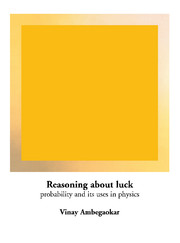Book contents
- Frontmatter
- Contents
- Preface
- 1 Introduction
- 2 The likely, the unlikely, and the incomprehensible
- 3 Normality and large numbers
- 4 Examples
- 5 A little mathematics
- 6 Forces, motion, and energy
- 7 Atoms, molecules, and molecular motion
- 8 Disorder, entropy, energy, and temperature
- 9 Heat, work, and putting heat to work
- 10 Fluctuations and the arrow of time
- 11 Chaos
- 12 Quantum jumps: the ultimate gamble
- Index
2 - The likely, the unlikely, and the incomprehensible
- Frontmatter
- Contents
- Preface
- 1 Introduction
- 2 The likely, the unlikely, and the incomprehensible
- 3 Normality and large numbers
- 4 Examples
- 5 A little mathematics
- 6 Forces, motion, and energy
- 7 Atoms, molecules, and molecular motion
- 8 Disorder, entropy, energy, and temperature
- 9 Heat, work, and putting heat to work
- 10 Fluctuations and the arrow of time
- 11 Chaos
- 12 Quantum jumps: the ultimate gamble
- Index
Summary
Lest men suspect your tale untrue
Keep probability in view
John GayThe mathematical theory of probability was born somewhat disreputably in the study of gambling. It quickly matured into a practical way of dealing with uncertainties and as a branch of pure mathematics. When it was about 200 years old, the concept was introduced into physics as a way of dealing with the chaotic microscopic motions that constitute heat. In our century probability has found its way into the foundations of quantum mechanics, the physical theory of the atomic and subatomic world. The improbable yet true tale of how a way of thinking especially suited to the gambling salon became necessary for understanding the inner workings of nature is the topic of this book.
The next three chapters contain some of the basic ideas of the mathematical theory of probability, presented by way of a few examples. Although common sense will help us to get started and avoid irrelevancies, we shall find that a little mathematical analysis yields simple, useful, easy to remember, and quite unobvious results. The necessary mathematics will be picked up as we go along.
In the couplet by John Gay (1688–1732), the author of the Beggar's Opera, probability has a traditional meaning, implying uncertainty but reasonable likelihood. At roughly the same time that the verse was written, the word was acquiring its mathematical meaning.
- Type
- Chapter
- Information
- Reasoning about LuckProbability and its Uses in Physics, pp. 6 - 22Publisher: Cambridge University PressPrint publication year: 1996

